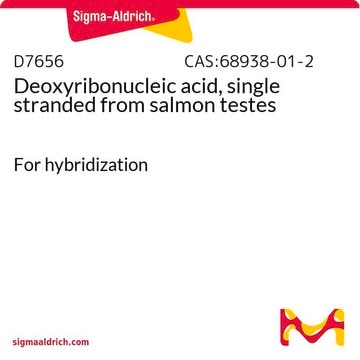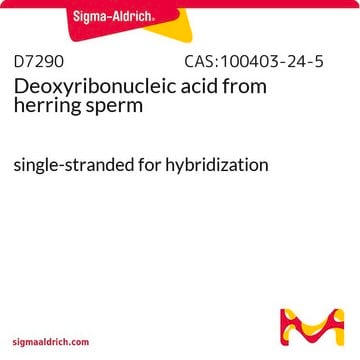D3035
Deoxyribonucleic acid from human placenta
buffered aqueous solution, sexed, female
Sinónimos:
DNA
About This Item
Productos recomendados
biological source
human placenta
grade
for molecular biology
form
buffered aqueous solution
shipped in
dry ice
storage temp.
−20°C
InChI
1S/C15H31N3O13P2/c16-13-1-7(20)11(28-13)5-25-32(21,22)31-9-3-15(18)29-12(9)6-26-33(23,24)30-8-2-14(17)27-10(8)4-19/h7-15,19-20H,1-6,16-18H2,(H,21,22)(H,23,24)
InChI key
AWBASQCACWFTGD-UHFFFAOYSA-N
¿Está buscando productos similares? Visita Guía de comparación de productos
Categorías relacionadas
General description
Application
- to compare the efficiency of DNA quantification methods
- as a standard in real-time PCR analysis of DNA samples from bladder cancer cell lines
- as an internal control to estimate the degree of fragmentation of circulating DNA
- for restriction digest analysis to identify low copy repeat regions of human chromosome 22q11
- to compare the 70-bp P5 exon sequence between DNA of different human and primate species
- to calculate copy number of genes, relative to normal human tissue
- in PCR reactions
Recommended products
related product
Storage Class
11 - Combustible Solids
wgk_germany
WGK 3
flash_point_f
Not applicable
flash_point_c
Not applicable
ppe
Eyeshields, Gloves, type N95 (US)
Certificados de análisis (COA)
Busque Certificados de análisis (COA) introduciendo el número de lote del producto. Los números de lote se encuentran en la etiqueta del producto después de las palabras «Lot» o «Batch»
¿Ya tiene este producto?
Encuentre la documentación para los productos que ha comprado recientemente en la Biblioteca de documentos.
Nuestro equipo de científicos tiene experiencia en todas las áreas de investigación: Ciencias de la vida, Ciencia de los materiales, Síntesis química, Cromatografía, Analítica y muchas otras.
Póngase en contacto con el Servicio técnico








